Samsung Galaxy Tab S Review (10.5 & 8.4-inch)
by Anand Lal Shimpi on June 24, 2014 9:00 AM EST- Posted in
- Tablets
- Samsung
- Mobile
- Galaxy Tab S
Display
In addition to the dramatically reduced chassis thickness, the move to a Super AMOLED display is the other flagship feature of the Galaxy Tab S lineup. Both devices feature a 2560 x 1600 Super AMOLED panel. The 10.5-inch model features a derivative of the S-Stripe RGB subpixel layout and geometry we first saw in the Galaxy Note 2.
Each pixel features loosely spaced red, green and blue subpixels, with the latter being a thin strip in comparison to the more traditional rectangular red and green subpixels:
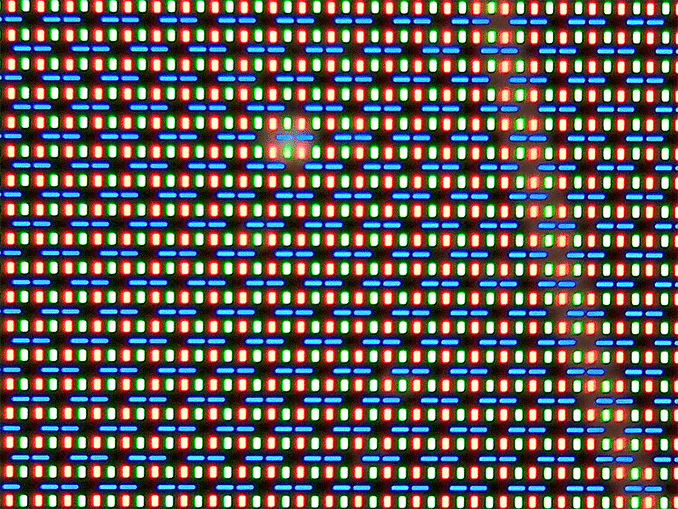
Samsung Galaxy Tab S 10.5, S Stripe RGB
Choosing different geometries for the blue subpixels makes sense as they have lower luminous efficiency than their red and green counterparts. Through balancing of subpixel size and drive power this design should allowed for equal luminance among all three subpixels. The uneven spacing is something new for the Galaxy Tab S 10.5, as the design looked far more structured back in the Note 2 days.
The 8.4-inch model by comparison uses a diamond PenTile RG,BG layout:
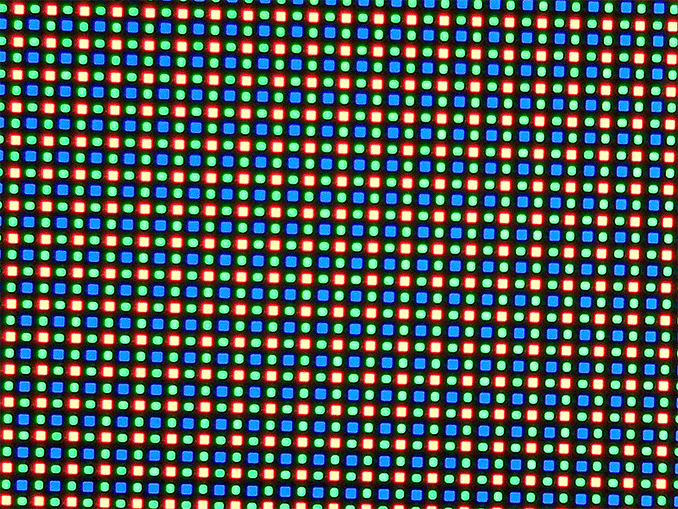
Samsung Galaxy Tab S 8.4, Diamond PenTile
This is similar to what we saw on the Galaxy Note 3, and just like before you get two subpixels per unit pixel instead of three in a traditional RGB stripe. Thankfully the pixel density on the Galaxy Tab S 8.4 is high enough that I wasn’t able to discern individual pixels or be bothered by the diamond PenTile layout. I will admit that I’ve never been the most sensitive to PenTile or PenTile-like sub pixel arrangements, so your mileage may vary.
With the Galaxy S5, Samsung finally delivered a reasonably accurate out of box display calibration as an option. In bringing AMOLED to its tablet lineup, I wondered if Samsung would do the same here. Thankfully the answer appears to be yes.
The new displays have the same adaptive setting as the GS5, which adjusts display tint based on ambient light temperature. There are three predefined color settings, down from the five on Galaxy S5, if you prefer something a bit more predictable.
Although Cinema ends up being the most accurate on the GS5, AMOLED Cinema doesn’t get the same treatment on the Galaxy Tab S. It’s actually the new basic mode that most closely tracks with sRGB. The two AMOLED modes trade off color accuracy for more saturation. I ran our display suite through all of the modes on the Galaxy Tab S 10.5 to illustrate the difference:
| Samsung Galaxy Tab S 10.5 Color Profiles | |||||||||
| Average White Point | Grayscale DeltaE 2000 | Gamut DeltaE 2000 | Saturation Sweep DeltaE 2000 | GMB ColorChecker DeltaE 2000 | |||||
| AMOLED - Cinema | 7540K | 5.2572 | 6.8855 | 5.9306 | 7.0418 | ||||
| AMOLED - Photo | 6576K | 1.7425 | 4.8109 | 4.5933 | 3.3633 | ||||
| Basic | 6516K | 1.8378 | 2.8114 | 2.6195 | 2.4249 | ||||
| Basic (Galaxy Tab S 8.4) | 6294K | 2.3914 | 3.4564 | 2.7639 | 2.2186 | ||||
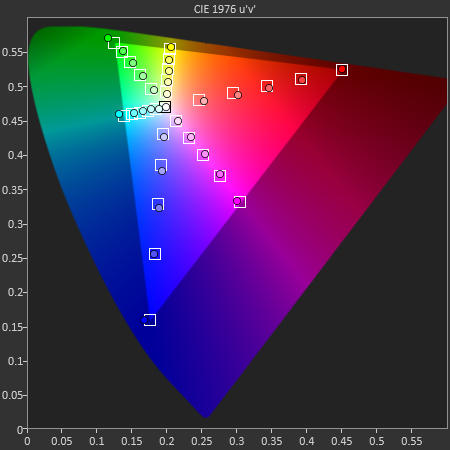
I’ve also included all of the CIE diagrams and test swatch comparisons in a gallery below if you want to have a closer look at what the AMOLED modes do. In short, both the photo and cinema modes oversaturate just in different ways. Photo appears to saturate evenly across all colors, while cinema mode compresses some while pushing out others.
As it’s the most accurate setting, I ran all of our comparison data with the basic mode enabled. In this mode the Galaxy Tab S’ display is among the best we’ve ever tested. On top of having good color accuracy, the new display delivers the awesome contrast ratio that AMOLED displays are known for. As you’ll see later on, there are definite power benefits as well when it comes to watching movies on these displays.
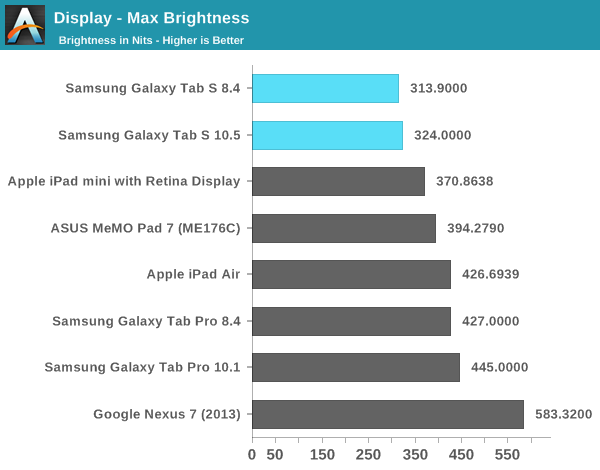
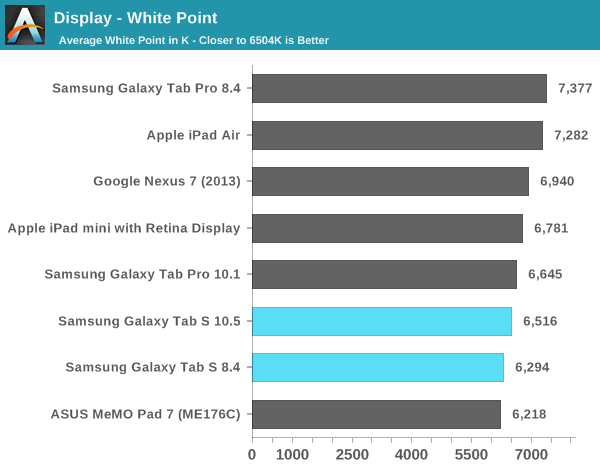
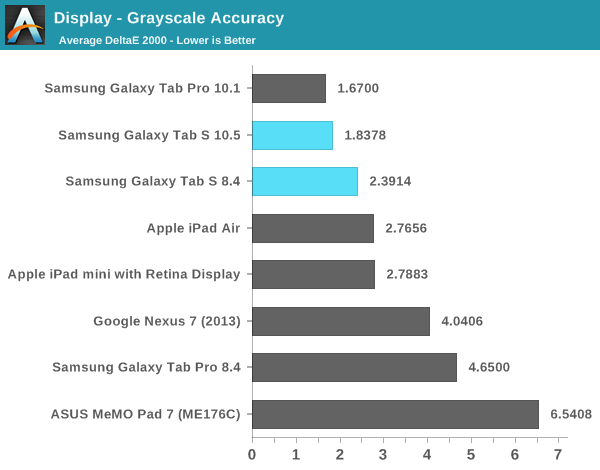
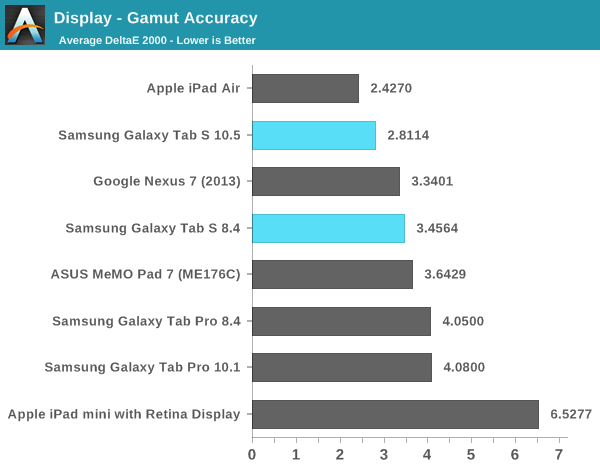

Samsung Galaxy Tab S 10.5 - Basic Profile

Samsung Galaxy Tab S 10.5 - Basic Profile

Samsung Galaxy Tab S 8.4 - Basic Profile

Samsung Galaxy Tab S 8.4 - Basic Profile
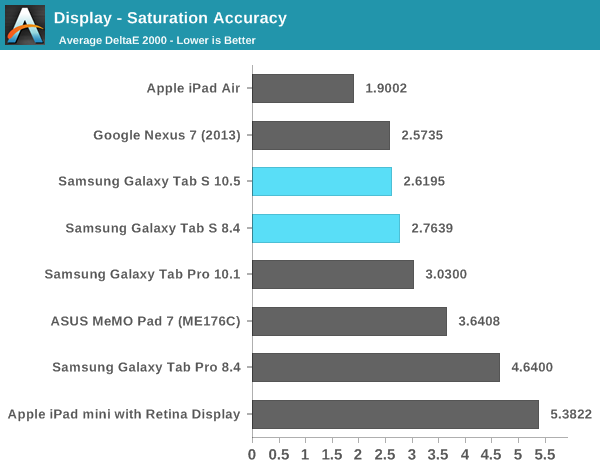

Samsung Galaxy Tab S 10.5 - Basic Profile

Samsung Galaxy Tab S 8.4 - Basic Profile
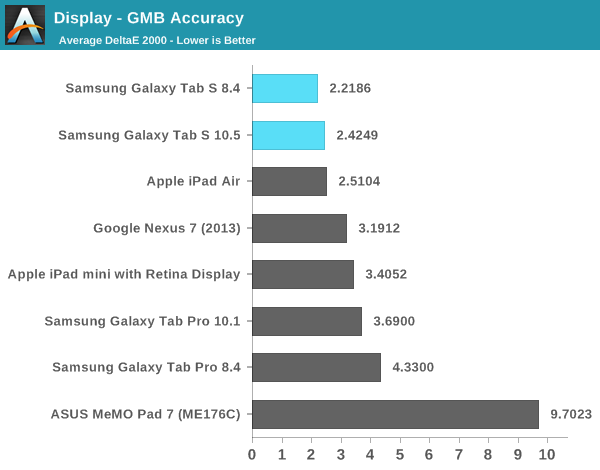
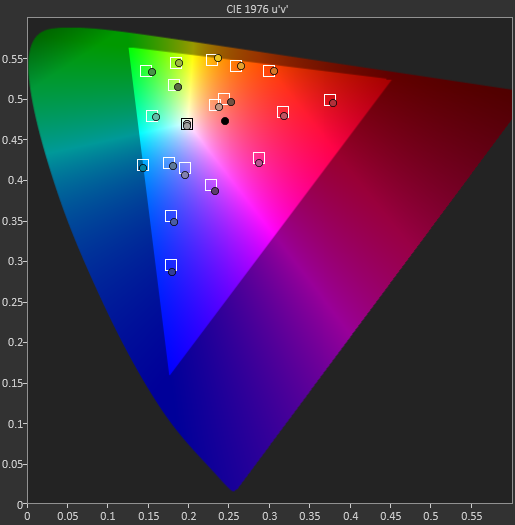
Samsung Galaxy Tab S 10.5 - Basic Profile

Samsung Galaxy Tab S 10.5 - Basic Profile

Samsung Galaxy Tab S 8.4 - Basic Profile

Samsung Galaxy Tab S 8.4 - Basic Profile


















98 Comments
View All Comments
dylan522p - Tuesday, June 24, 2014 - link
All points are not equal, Saturation and gamut are far mmore important.name99 - Wednesday, June 25, 2014 - link
This really seems like the narcism of small differences.Judging from Anand's comments, both displays are spectacular, and more fruitful avenues of competition would appear to be based on features other than improving the metrics Anand is measuring.
Given what appears to be substantially lower power (when displaying dark scenes) Samsung comes out ahead --- of course this is of little value if they do worse on displaying white scenes, which also appears to be the case, and if (like me) you spend most of your time reading black text against a white background.
In future whoever gets to variable refresh first (both to save power, and to display 24 and 48 fps content at the native rate) will have achieved a more useful advantage. Likewise I suspect that for at least some purposes an available refresh rate of higher than 60 fps (maybe 72, maybe 90 or even 120) may be valuable --- I don't know how high you need to go before motion (especially the difficult cases like horizontal pans) never judders.
lilo777 - Tuesday, June 24, 2014 - link
Let me just quote DisplayMate - a well know specialist in display evaluations: "Based on our extensive Lab tests and measurements, the Galaxy Tab S is the Best Performing Tablet Display that we have ever tested, not surprisingly with performance that is almost identical to the OLED Galaxy S5 Smartphone that we recently tested and found to be the Best Performing Smartphone Display."While I appreciate AnanTech reviews very much for their comprehensiveness when it comes to displays I prefer the opinion of the specialists in the field. You can read DisplayMate's full review here: http://www.displaymate.com/OLED_Tablet_ShootOut_1....
dylan522p - Tuesday, June 24, 2014 - link
You mean biased as fuck? He calls 113% gamut "great" and he says the saturation is also great look at the numbers and you see it's bullshit.the_ether - Tuesday, June 24, 2014 - link
Where does he say that?From what I can see, in reference to a gamut of 113% he has said, "Slightly Too High," and that is in reference to sRGB and the screen being in 'Basic Mode' instead of 'Photo Mode'. When in 'Photo Mode', the Samsung screen is said to be within 106% of the larger, Adobe RGB gamut.
Of course, a wide gamut capability is pointless without accuracy and according to his tests, the Samsung 10.5 screen is either "Very good" or "Excellent."
hung2900 - Tuesday, June 24, 2014 - link
I agree with the_either. Displaymate rated carefully and not biased.Color gamut:
- Air 108%: very good.
- Tab S 10.5 113%: slightly too high.
Absolute Color Accuracy Average Color Error:
- Air 3.2 JNCD Very good.
- Tab 10.5 2.1 JNCD Excellent
Absolute Color Accuracy Largest Color Error
- Air 7.9 JNCD Good.
- Tab 10.5 4.0 JNCD Very good.
So nothing wrong when Displaymate said Tab S has better color accuracy and is the best tablet display yet in market when combining with other factors.
P/s sorry for my rude comment above
the_ether - Tuesday, June 24, 2014 - link
Thank you hung2900.mhannigan - Wednesday, June 25, 2014 - link
You didn't read. One of the things he makes a point of several times is the ability to change the screen calibration. He notes that many people find the increased saturation pleasing to the eye - I do. But if you don't like it, there are other options, two of which are spot on with industry standard color gamut.ddriver - Tuesday, June 24, 2014 - link
It is hard to take anand reviews seriously just looking at their "CPU benchmark" choices, plus their heavy bias toward apple products. DisplayMate go further with testing and are more objective in their conclusions.hung2900 - Tuesday, June 24, 2014 - link
Anand's CPU comparison is so apple-and-orange comparison. Everyone know Sunspider is the mix of Browser optimization, CPU power and how CPU optimized toward browsing. Why didn't he use Chrome to mesure the Sunsipder of iOS?